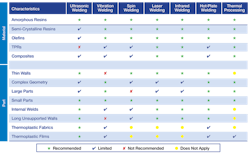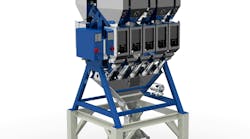Manufacturers wanting to join plastic parts have three main methods available — mechanical joining, adhesives or welding.
A number of variables, including product designs and geometries and the compatibility of the plastics involved, go into selecting the best option, said Marcus Chiesa, applications development engineer for assembly technologies at Emerson Electric Co., which owns the Branson brand of plastic welding equipment. Branson has more than 70 years of experience offering a broad portfolio of joining technologies.
Mechanical joining options include screws, rivets, and snap- and press-fit joints. These components are well-suited for use on items that may require future disassembly.
Adhesives can be costly, and curing takes time. In addition, adhesives might be inappropriate for some products, such as medical devices. Emerson can work with clients to determine the best solution, Chiesa said. It might involve combining a welding technology, like ultrasonic welding, with mechanical technology, like the insertion of posts, to develop a reliable bond, he said.
According to Emerson, the most popular welding approaches are ultrasonic welding, vibration welding, laser welding, infrared welding, spin welding, thermal processing and hot-plate welding.
“It typically depends on the market; automotive and medical, for example, they have their own niche requirements,” Chiesa said. “Very generally speaking, ultrasonics is the big one.” Ultrasonics, he said, is relatively fast and generally carries the lowest cost.
Jason Barton, director of business development in the Americas for Dukane, another major manufacturer of welding equipment, also cites ultrasonic welding as a popular technology.
“The most popular, probably by a long shot, is ultrasonic welding,” Barton said. “You probably have ultrasonic welding up there as No. 1, and a distant No. 2 is vibration welding. What is catching up to vibration welding is infrared welding. That can be used in combination with vibration welding or on its own.”
After those technologies, Barton cited laser welding, which is “becoming more economical.”
Paul Mauro, owner of Plastic Assembly Systems, said heat staking, which is one form of thermal processing, is among the most popular technologies requested by his customers. One common application is attaching a circuit board to a plastic part, he said.
“It’s really driven by what the customer is trying to accomplish,” Mauro said. “I’m not sure there is one particular process that is king, per se, because they all do different things. I would say the leading ones are heat staking, ultrasonic welding, spin welding and hot-plate welding.”
A major consideration when selecting a plastic welding technology is cost.
“You have investment, which is always important for customers,” Barton said. “Ultrasonic welding, the price points start as low as $5,000 for a basic little hand-held system, and they go up to $50,000 for a servo-controlled benchtop press. When you start talking about vibration welding and infrared welding, a vibration welder is going to be anywhere from $125,000 to $200,000, which is a machine and tooling. You can see how the price points change. …
“I don’t want to beat the drum for ultrasonics all the time, but the reason people buy them is the lower investment, and it is very flexible.”
However, ultrasonic welding is limited mostly to small- and medium-size parts. Size limitations can depend on the frequency of the ultrasonic welder (the higher the frequency, the smaller the part), and the type of plastic being welded. Softer materials, like nylon, can be difficult or impossible to ultrasonically weld because soft material deadens ultrasonic vibrations.
Below are the basics of some of the most popular plastic welding methods:
Ultrasonic: Ultrasonic welding uses a power supply, converter, booster, horn and actuator to deliver mechanical vibration and force to parts being joined. The high-frequency vibration generated by these components produces heat, which melts the plastic and produces a strong bond. Advantages include fast cycles, low capital expenditure and the fact that the bonds require no curing.
Limitations include a narrow material range, and the inability to join large parts and handle complex geometries. The most common frequencies used for ultrasonic welding range from 15 kilohertz (kHz) to 40 kHz, according to Emerson.
Vibration: Vibration welding equipment holds two parts together at a precisely determined pressure and applies a repetitive linear motion to one of the parts. This causes friction where the two parts meet, melting the adjoining surfaces and, as the parts cool, a bond forms. The frequencies used in vibration welding are lower than ultrasonic welding, ranging from 100 hertz (Hz) to 200 Hz, but the amplitude of the vibrations is larger, ranging from 0.03 inch to 0.16 inch, according to Emerson.
Vibration welding can be used with a wide variety of thermoplastics as well as larger parts and ones with more complex shapes. Its limitations include the creation of some flash and particulates.
Laser: Laser welding is a gentle, clean and precise joining process suitable for complex geometries and materials that are difficult to bond via other common welding techniques, Emerson said. Unlike ultrasonic and vibration welding, no motion or friction between the components being joined is required. Instead, a laser heats the components. The lack of movement between the parts ensures that weld alignment and sealing are precise; it also prevents the creation of flash or particulates.
However, one limitation is that one component’s material must be transmissive (allowing the laser beam to pass through it), and the second component must be made of a light-absorbent material. Also, laser welding can only be used with small- to medium-sized parts.
Infrared: Infrared welding, like laser welding, is a noncontact method. The welders use infrared emitters to deliver precise levels of invisible radiant heat to mating surfaces for specified intervals. When the heat is removed, the mating surfaces are compressed and cooled in the welding tool to produce a strong, airtight weld free of particulates and flash, Emerson said. Infrared welders work with a wide range of materials and can handle large parts with complex geometries. However, they require longer cycle times and more complex tooling than other welding methods.
Spin welding: Spin welding, like ultrasonic and vibration welding, relies on heat generated by friction for joining two thermoplastic parts. However, spin welds are suitable only for circular parts and are achieved by rotating one part against a second, stationary part. Once the rotation stops, the parts are held together for a short amount of time to form the bond. The cycle time is fast, but some flash and particulates result.
Heat staking: Heat staking uses a heated metal tip to soften and re-form plastic into a desired shape. A plastic stud from one component is inserted into a hole in a second component. A heated metal tip then melts the top of the stud to form a head and lock the two components together. At least one of the parts must be plastic, but heat staking can join the plastic part to metal, plastic or another material.
Hot-plate welding: Hot-plate welding involves loading parts into holding fixtures and bringing the plastic into contact with a heat platen. Once the mating surfaces are brought up to the melt temperature of the base resin, the heat platen is removed and the parts are brought together to form a weld. The tooling that touches the plastic parts is typically coated with Teflon as a release agent, according to Emerson.
Bruce Geiselman, senior staff reporter
Contact:
The Branson Ultrasonics brand of Emerson Electric Co.,
Danbury, Conn., 203-796-0400, www.emerson.com/Branson
Dukane,
St. Charles, Ill., 630-797-4900, www.dukane.com
Plastic Assembly Systems,
Bethany, Conn., 203-393-0639, www.heatstaking.com







